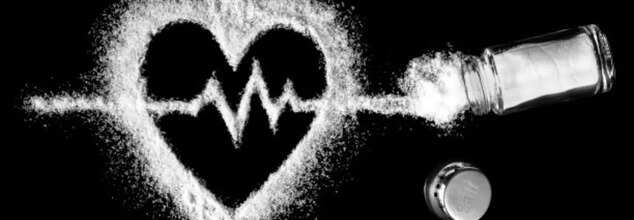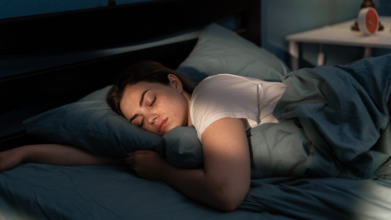- Health Conditions A-Z
- Health & Wellness
- Nutrition
- Fitness
- Health News
- Ayurveda
- Videos
- Medicine A-Z
- Parenting
- Web Stories
How Can Too Much Salt Increase Your Risk of Heart Attack

Heart Health (Credit: Canva)
Can eating too much salt lead to a heart attack? Yes, it can. While sweets, due to their association with cholesterol, lead to heart-related issues, excessive salt consumption is equally dangerous. Salt contains sodium, which can raise blood pressure and contribute to Coronary Heart Disease (CHD). If not controlled, high sodium intake can eventually lead to a heart attack.
Why Do You Need Sodium?
Sodium is a mineral that aids the healthy function of nerves and muscles and helps keep your body’s fluid levels in proper balance. But that fluid balance is delicate. Speaking to Cleveland Clinic, cardiologist Dr Luke Laffin said, "Too much sodium can cause fluid retention, which can increase blood pressure. And high blood pressure is a major risk factor for heart attack, stroke and heart failure."Excessive salt can also contribute to the stiffening of arterial walls, which can impair blood flow and increase the risk of cardiovascular events, including heart attacks.
What Foods Are High On Sodium?
Many commonly consumed foods are surprisingly high in sodium, often due to processing and preservation methods. Processed meats like bacon, ham, and sausages, along with canned entrees and salted nuts, are notorious for their high sodium content. Additionally, frozen dinners, including pizza and burritos, can also contribute to excessive sodium levels. To mitigate these risks, it's important to opt for alternatives with low content of the mineral, such as fresh or frozen meats, eggs, and dry beans. Choosing low-sodium canned fish and unprocessed nuts can also help maintain a healthier sodium balance.Dairy products and snacks are other major sources of sodium in the diet. Regular cheeses, buttermilk, and processed cheese spreads can be high in sodium, while packaged snacks like salted crackers and prepackaged potato mixes further contribute to daily sodium intake. Switching to low-sodium cheeses, unsalted crackers, and homemade potato dishes can help reduce sodium consumption. Fresh fruits and vegetables, along with low-sodium canned options, offer nutritious, low-sodium alternatives. By making these simple substitutions, individuals can effectively manage their sodium intake and support better heart health.
Here's How You Can Control Your Sodium Intake
The following steps will help you lower your sodium intake:- Read Nutrition Labels: Check the sodium content on food packaging to make informed choices and opt for lower-sodium options.
- Cook at Home: Prepare meals using fresh ingredients and limit the use of salt and processed foods.
- Use Herbs and Spices: Enhance flavor with herbs, spices, and lemon juice instead of adding salt.
- Choose Low-Sodium Products: Opt for low-sodium or no-salt-added versions of packaged and canned foods.
- Limit Processed Foods: Reduce consumption of processed and packaged foods, which often contain high levels of sodium.
- Rinse Canned Foods: Rinse canned vegetables, beans, and fish to remove excess sodium.
- Avoid Adding Salt at the Table: Skip the salt shaker and use alternatives like pepper or vinegar to season food.
- Be Cautious with Condiments: Use condiments like soy sauce, ketchup, and salad dressings sparingly, as they can be high in sodium.
- Eat More Fresh Fruits and Vegetables: Focus on whole, unprocessed fruits and vegetables that are naturally low in sodium.
- **Stay Hydrated**: Drink plenty of water to help your body balance sodium levels and maintain overall health.
Metabolic Doctor Reveals Simple Routine That Can Lower Your Blood Sugar In 14 Days

(Credit-Canva)
Food is one of the best ways to de-stress when you are working under pressure and are worried about things in your life. However, relying only on food to cheer you up can lead you down a path that can increase your blood sugar and put your health at risk.
High blood sugar is much more common than people realize, in 2022 adults over the age of 18 years were living with high blood sugar. What’s surprising is that a lot of them did not even know they have high blood sugar. However, why is high blood sugar a cause of concern?
What Happens When Blood Sugar Is High?
When blood sugar levels stay high for a long time or get very high, it can cause serious, permanent damage to your body. This can lead to nerve damage in your hands and feet, vision problems, and even a life-threatening condition called diabetic ketoacidosis. If you have high blood sugar, your doctor might have you test for ketones, as a high level of these can be a sign of this dangerous condition.
Symptoms of high blood sugar usually appear gradually and may not become noticeable until your blood sugar levels are quite high. The most common signs to watch for are:
- Feeling very thirsty.
- Peeing a lot.
- Feeling weak or tired.
- Having blurry vision.
- Losing weight unexpectedly.
14 Day Routine That Can Lower Your Blood Sugar
For people with diabetes, several things can cause blood sugar levels to rise. These include being sick or feeling stressed, eating too many foods that are high in sugar or starch, not being as active as you normally are etc.
According to the post, this 14-day plan to help manage blood sugar without relying solely on medication. These tips focus on diet, physical activity, and timing to help you control your body's blood sugar levels.
Avoid Sugary Drinks and Refined Grains
Cut out drinks like sodas, juices, and sweetened teas, as they cause a rapid spike in blood sugar. Similarly, processed carbs like white bread and white rice break down quickly into sugar. Instead, choose whole grains.
Eat Cinnamon Daily
Adding just a half-teaspoon of cinnamon to your morning tea or food can help improve your body's sensitivity to insulin, which is the hormone that moves sugar from your blood into your cells.
Start Meals with Fiber-Rich Salad
Eating a salad first can help slow down the digestion of the rest of your meal. The fiber in the salad creates a kind of protective barrier in your gut, which keeps your blood sugar from spiking too quickly after you eat.
Choose Complex Carbs
Instead of simple carbs, like those found in sweets and white flour, choose complex carbs. These are found in foods like whole grains, vegetables, and beans. They are rich in fiber, which helps your body absorb sugar more slowly and steadily.
Replace Sugar with Natural Sweeteners
Try using natural, zero-calorie sweeteners like stevia or monk fruit instead of regular sugar. These can satisfy your sweet tooth without affecting your blood sugar levels.
Eat Small, Frequent Meals
Eating three big meals can lead to large blood sugar spikes. A better approach is to eat several smaller meals throughout the day. This helps keep your blood sugar levels more stable and prevents extreme highs and lows.
Physical Activity and Other Habits
Walk 20 Minutes After Every Meal
A short walk after you eat can do wonders. Physical activity helps your muscles use up the sugar in your bloodstream for energy, which prevents blood sugar levels from rising too high.
Drink Bitter Gourd Juice
This traditional remedy is often used to help manage blood sugar. Drinking it three times per week may support your body's ability to use glucose effectively.
Not Just For Rest, A Good Night Sleep Can Flush Out Dementia-Linked Toxins

Credits: iStock
Scientists have long been puzzled over how the brain clears away its own waste. Unlike the rest of the body, which relies on the lymphatic system to carry waste from cells into circulation, the brain appeared to have no such mechanism. That mystery shifted about 12 years ago when researchers discovered the glymphatic system, a network that acts as the brain’s built-in cleaning service.
The glymphatic system works by circulating cerebrospinal fluid (CSF) through the brain’s tissues. This fluid enters the spaces between brain cells, collects waste, and carries it out along large veins. In animal studies, particularly in mice, the system appears most active during sleep. That discovery suggested that sleep might be essential for brain detoxification, and disrupted rest could interfere with waste clearance.
Among the most important toxins flushed out by the glymphatic system is amyloid beta (Aβ), a protein that, when accumulated, forms sticky plaques in the brain. These plaques, along with tangles of tau protein, are a defining feature of Alzheimer’s disease—the most common cause of dementia worldwide.
The idea that better sleep helps the brain clean itself is more than a scientific curiosity. It may help explain why people who consistently struggle with poor sleep face higher risks of dementia.
In humans, levels of amyloid beta in cerebrospinal fluid rise during waking hours and drop during sleep, suggesting that rest is when the brain “takes out the trash.” In one striking experiment, researchers kept healthy adults awake for a single night. Just 24 hours of sleep deprivation increased amyloid beta in the hippocampus, the brain region essential for memory and one of the first to show damage in Alzheimer’s disease.
Still, questions remain. While several mouse studies indicate the glymphatic system is most active at night, other recent experiments suggest it may work differently depending on the time of day or even the species. The debate highlights how much more we need to learn about how this system functions in humans.
How Do Sleep Disorders Increase Risk of Dementia?
Not all sleep is equal. Short-term sleep loss is harmful, but chronic sleep problems can be particularly damaging to brain health.
Sleep Apnoea
Sleep apnoea, where breathing repeatedly stops and starts during sleep, deprives the brain of oxygen and fragments rest. Both oxygen deprivation and chronic sleep disruption are thought to contribute to toxin build-up in the brain. Importantly, studies show that patients treated for sleep apnoea—often with continuous positive airway pressure (CPAP) machines—see greater clearance of amyloid beta. This suggests that treatment may help restore the brain’s waste-disposal rhythm.
Insomnia
Insomnia, defined as difficulty falling or staying asleep, has also been linked to higher dementia risk. While the association is clear, the mechanism is less so. Does insomnia accelerate amyloid build-up? Could treatment reverse the trend? Researchers are only beginning to explore whether therapies—such as orexin receptor antagonists, a new class of sleep drugs—might improve toxin clearance.
Untreated sleep disorders don’t just leave you tired—they may be undermining your brain’s long-term health.
Can Sleep Prevent Dementia?
While early findings are promising, science isn’t yet ready to declare sleep a cure for dementia. What researchers do know is that sleep deprivation can rapidly alter amyloid levels in the brain, and chronic sleep disorders such as apnoea and insomnia are associated with a higher risk of developing dementia. Treating sleep apnoea appears to improve amyloid clearance, though evidence regarding the effects of insomnia treatment remains limited.
What remains uncertain is whether improving sleep directly reduces dementia risk. Large, long-term clinical studies are still needed to confirm the link. Researchers are actively pursuing this question, measuring proteins like amyloid beta and tau in blood and spinal fluid across sleep-wake cycles, in both healthy individuals and those with sleep disorders.
The global dementia burden is growing. Alzheimer’s and related dementias currently affect more than 55 million people worldwide, with cases expected to triple by 2050. While scientists race to develop new drugs, lifestyle measures—such as improving sleep—are emerging as powerful, accessible tools for prevention.
If better sleep helps the glymphatic system flush out harmful proteins, prioritizing rest may be one of the simplest ways to protect long-term brain health. That means:
- Maintaining a consistent sleep schedule.
- Addressing sleep disorders like apnoea with medical guidance.
- Seeking help if insomnia is chronic.
While the science continues to evolve, the advice remains practical: treat sleep as essential, not optional.
The glymphatic system is a reminder that the brain, like the body, needs maintenance. Just as poor diet, smoking, or lack of exercise take their toll, chronic sleep disruption may leave toxins lingering in the brain, setting the stage for cognitive decline.
The exciting part is that this field of research is still in its infancy. Scientists are mapping the biology of how the brain cleans itself and testing new ways to boost that process. Whether through targeted drugs, therapies for sleep disorders, or simply protecting natural sleep cycles, the future may bring strategies to slow or even prevent dementia.
'Breast Cancer Symptoms Don't Always Come As Lumps' Breast Cancer Surgeon Reveals 4 Key Points Everyone Should Know

(Credit-Canva)
Breast cancer is one of the leading causes of death for women all over the world. It is the most common cancer diagnosed in American women and a leading cause of cancer death in less developed countries. In India alone, cancer cases are projected to reach over 1.5 million by 2025.
Since this disease is so widespread, it's essential to be well-informed. Dr. Lauren Ramsey, a breast cancer surgeon, shared four important facts that she believes every woman should know. These tips, originally posted on her Instagram, provide crucial information for understanding breast cancer risk and detection.
Family History Is Not the Only Risk Factor
Only a small number of breast cancer cases—about 5-10%—are actually caused by genes you inherit, such as the BRCA mutation. This means that most breast cancers are not passed down through families.
Therefore, even if no one in your family has ever had breast cancer, it's still extremely important for you to get regular screenings, like mammograms. Relying only on family history can give you a false sense of security, so remember that breast cancer can affect anyone, and consistent check-ups are your best defense.
Look Beyond a Lump
Many people think that the only sign of breast cancer is a lump. However, this isn't true. It's really important to pay attention to other changes in your breasts, because they can also be a sign of cancer.
Be on the lookout for things like changes in your skin, such as redness or dimpling (like an orange peel). Other signs can include swelling, a new pain that doesn't go away, or any unusual discharge from your nipple. Knowing what your breasts normally look and feel like is key to spotting these more subtle changes early.
Breast Density Affects Detection
Breast density refers to how much fibrous and glandular tissue a person has compared to fatty tissue. Many people, especially younger women, have naturally dense breasts. While this is completely normal and not a health problem on its own, it can make it harder for doctors to see breast cancer on a standard mammogram.
That's because both dense tissue and tumors appear white on a mammogram, making it difficult to tell them apart. If you have dense breasts, your doctor might recommend extra tests, like an ultrasound or an MRI, to get a clearer picture. You can ask your doctor about your breast density after your mammogram.
Lifestyle Changes Can Make a Difference
The healthy habits you often hear about—like eating well and exercising—are not just a suggestion; they can actually lower your risk of developing breast cancer. Making simple changes can have a big impact. Try to limit the amount of alcohol you drink and reduce your intake of processed foods, which are often high in sugar and unhealthy fats.
At the same time, try to be more physically active every day. Even a short daily walk can help. These positive choices are a great way to take control of your health and reduce your risk. This information is shared with care, so everyone can be empowered with knowledge about their health.
© 2024 Bennett, Coleman & Company Limited

